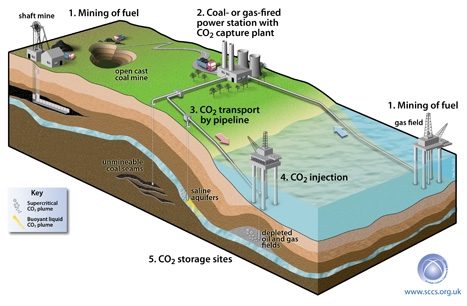Geological storage is a popular potential option for storing carbon dioxide captured from industrial processes or combustion related to electricity generation; the idea is to pump the gas into depleted natural gas wells or other naturally occurring subterranean geological structures.
However, the security of this technique depends on being certain that the injected gas remains where it is supposed to be and does not migrate through the geology. To date, no method has been found to accurately distinguish injected CO2 from natural sources of the gas.

Building on previous research that suggested chemical tracers could be added to the injected CO2 , a team at the University of Edinburgh, one of the partner institutes of the research partnership Scottish Carbon Capture and Storage, undertook research to try to clarify one of the problems with the technique: a poor understanding of how such tracers would move below ground.
In the journal Chemical Geology, a team led by Dr Rachel Kilgallon of the University’s School of Geosciences describes how it used mass spectroscopy to conduct time trials of how different chemical tracers, including noble gases and sulphur hexafluoride, a standard tracer compound used in industry, percolate through sample different porous sandstones.
The noble gases krypton and xenon were used because, although sulphur hexafluoride is a common and well understood substance in the oil and gas industry, it is also a potent greenhouse gas, whereas noble gases are naturally occurring in the atmosphere and did not affect the climate, explained Stuart Gilfillan, who coordinated the study.
The researchers found that the tracers take different times to travel through the same length of rock, but all of them arrived ahead of the carbon dioxide to which they had been added. This suggests that they could be used to detect any movement of the gas after it had been pumped into storage.
“Our work highlights that added tracers would provide an early warning of any unplanned migration of the injected CO2," said Kilgallon. “Our findings confirm results from large-scale experiments in the USA, where tracers were seen to travel faster than CO2 through the rocks.”
Gilfillan added: “This new knowledge about the behaviour of CO2 and tracers in the subsurface will help in the development of monitoring techniques to ensure secure carbon storage. We found that the time taken for krypton and xenon to flow through the rock sample was almost identical to that of sulphur hexafluoride."





Glasgow trial explores AR cues for autonomous road safety
They've ploughed into a few vulnerable road users in the past. Making that less likely will make it spectacularly easy to stop the traffic for...